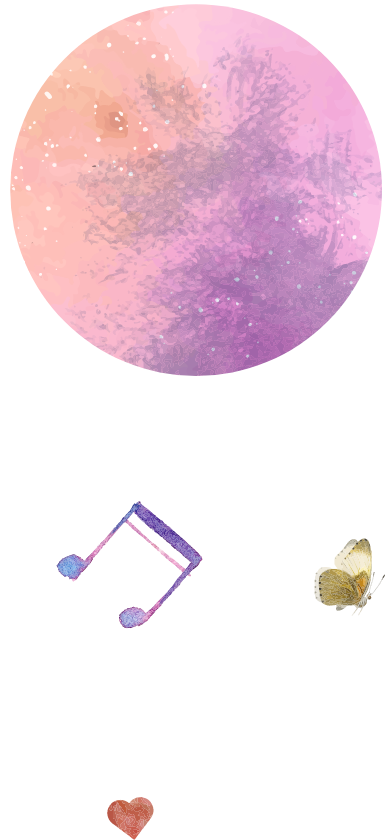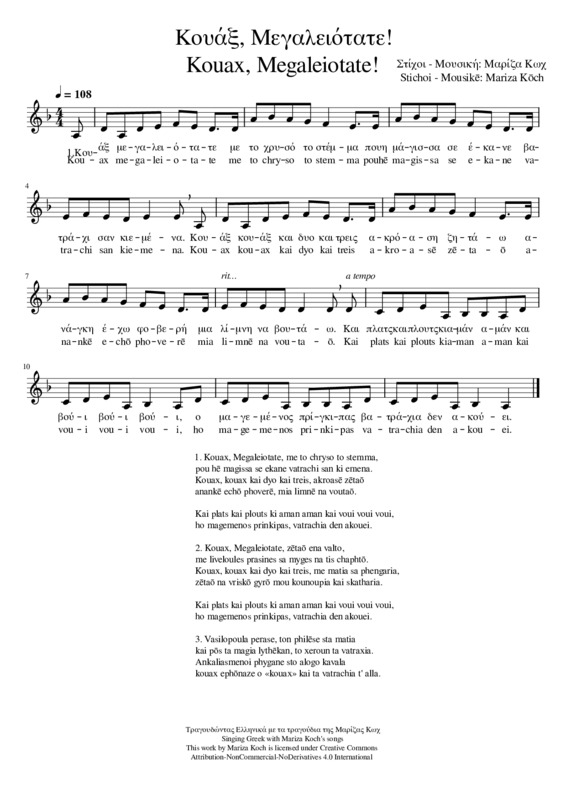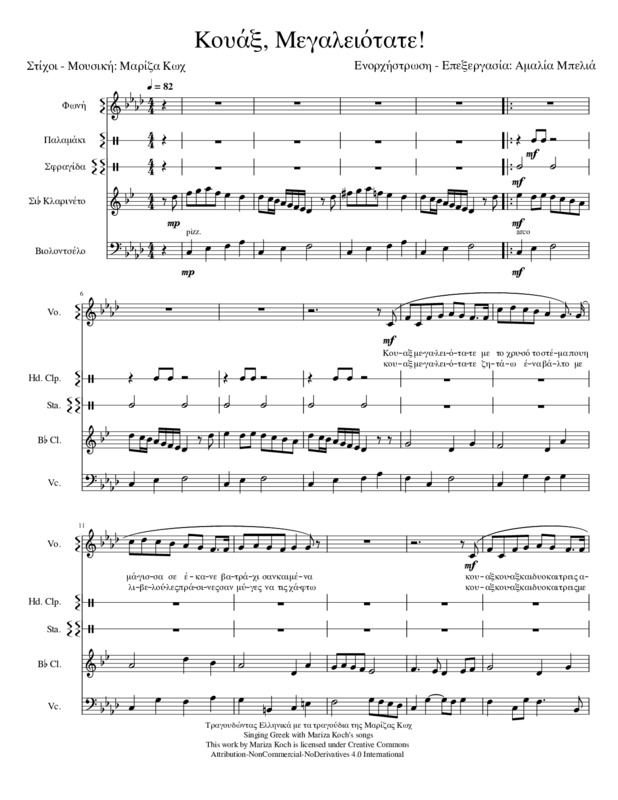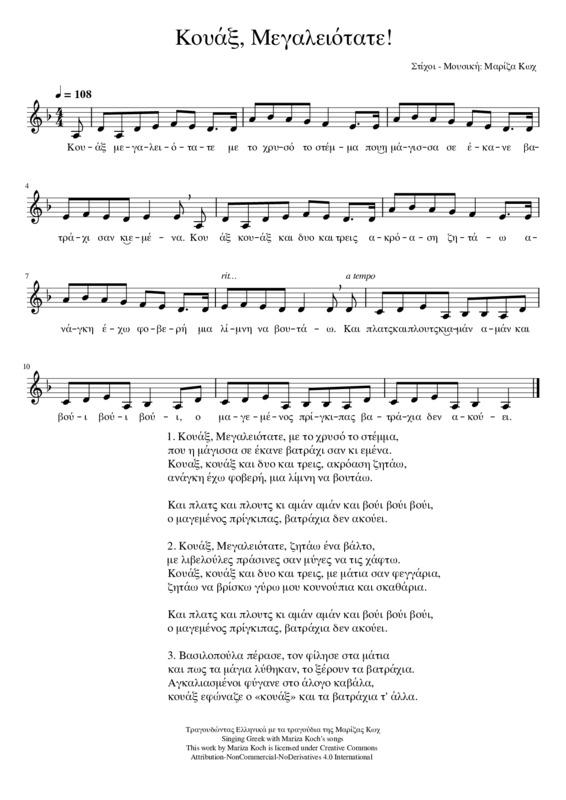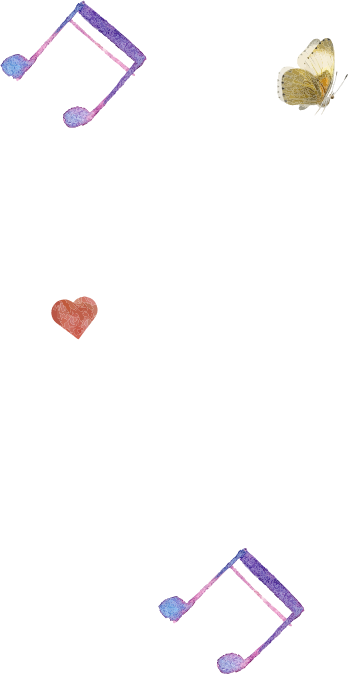
Kouax, Megaleiotate!

Kouax, Megaleiotate!
Pronunciation
Articulation of double consonants /μπ/ [b (initially) and mp (medially and finally)], /ντ/ [nt (medially and finally) and d (initially)], /γκ/ [gk (initially and finally) and nk (medially)], and their use in the Greek language [μπακάλης (bakalēs, grocer), ντομάτα (domata, tomato), γκρεμός (gkremos, chasm), etc.].
Find these phonemes in other words of the Greek language. Articulation of the phoneme /π/ (p) and its use in the Greek language [πέφτω (pephtō, to fall), παρακαλώ (parakalō, to beg), etc.].
Repetition and good articulation of vowels ου-ο-ι-ε-α (ou-o-i-e-a).
Find these phonemes in other words of the Greek language. Articulation of the phoneme /π/ (p) and its use in the Greek language [πέφτω (pephtō, to fall), παρακαλώ (parakalō, to beg), etc.].
Repetition and good articulation of vowels ου-ο-ι-ε-α (ou-o-i-e-a).
Speech Comprehension and Production
Search for the verbs of 2nd conjugation on the occasion of the ζητάω-ώ (zētaō-ō, to ask), βουτάω-ώ (voutaō-ō, to dive) of the poem. Form the Past Continuous and the Simple Past and transliterate the poem in a past tense.
Read the traditional fairy tale of the princess and the frog, identifying similarities and differences with the song.
Modify the end: What if the princess did not kiss the prince?
Utilize the third verse to produce a descriptive speech on the life and the environment of the frog.
Read the traditional fairy tale of the princess and the frog, identifying similarities and differences with the song.
Modify the end: What if the princess did not kiss the prince?
Utilize the third verse to produce a descriptive speech on the life and the environment of the frog.
Music Activities
Sing using rhythmic movements in the rhythm of the meter, with different movements during the refrain section that will remain the same each time the refrain is heard.
Listen to the recorded music of frogs.
Create a soundscape with frogs, dragonflies, and sounds that may be heard around a lake.
Arrange in a circle and assign one of the students to be the leader. The leader has to play a rhythmic pattern using the word kouax (croak), the next one has to repeat the rhythmic pattern, and everyone has to do the same in their turn. The exercise is completed when the pattern goes back to the leader. Unpitched percussion instruments can also be used during this activity.
Spread a blue cloth, representing the lake, in the middle of the class, and place circular shapes, like water lilies, on top of it (paper, carton, napkins, or paintings of water lilies). The students, imitating the frogs, jump from one water lily to another while listening to preferably water-themed recorded music (e.g. Haydn’s Water Music). When the music stops, the teacher has to remove a water lily, so the frogs share their nests with each other, or come out of the lake. At the end there is a water lily and a frog that will be the prince-frog or the princess-frog. The children sit like frogs on the shore of the lake holding dragonflies (made of transparent gelatin and wire), they are all frogs and they talk to the frog-king waving their dragonflies.
Create an improvised group composition using echomimetic words related to water on the occasion of those contained in the song and use the characteristics of the sound (pitch, volume, duration, tone) (e.g. πλατς (plats), πλουτς (plouts), πλιτς (plits), πλοτς (plots), βουι (voui), μπρρ (mprr), μπλλ (mpl), etc.).
Games with sounds created by the use of water in different materials (e.g. pebbles and stones falling into water, bottles or glasses with water that create different pitch etc.).
Listen to the recorded music of frogs.
Create a soundscape with frogs, dragonflies, and sounds that may be heard around a lake.
Arrange in a circle and assign one of the students to be the leader. The leader has to play a rhythmic pattern using the word kouax (croak), the next one has to repeat the rhythmic pattern, and everyone has to do the same in their turn. The exercise is completed when the pattern goes back to the leader. Unpitched percussion instruments can also be used during this activity.
Spread a blue cloth, representing the lake, in the middle of the class, and place circular shapes, like water lilies, on top of it (paper, carton, napkins, or paintings of water lilies). The students, imitating the frogs, jump from one water lily to another while listening to preferably water-themed recorded music (e.g. Haydn’s Water Music). When the music stops, the teacher has to remove a water lily, so the frogs share their nests with each other, or come out of the lake. At the end there is a water lily and a frog that will be the prince-frog or the princess-frog. The children sit like frogs on the shore of the lake holding dragonflies (made of transparent gelatin and wire), they are all frogs and they talk to the frog-king waving their dragonflies.
Create an improvised group composition using echomimetic words related to water on the occasion of those contained in the song and use the characteristics of the sound (pitch, volume, duration, tone) (e.g. πλατς (plats), πλουτς (plouts), πλιτς (plits), πλοτς (plots), βουι (voui), μπρρ (mprr), μπλλ (mpl), etc.).
Games with sounds created by the use of water in different materials (e.g. pebbles and stones falling into water, bottles or glasses with water that create different pitch etc.).
Cross-thematic Connections - Greek Culture
Interdisciplinary concepts: tradition, system (ecological).
The magical fairy tale in the folk tradition: Study the linguistic and narrative richness of the Greek folk fairy tales, as well as the fairy tales of the Grimm brothers, on which the song is based. Search for similarities of the fairy tale “The Frog Prince” by Grimm brothers with Greek traditional fairy tales that contain the magical element (Magical fairy tales).
The lake as a biotope and a soundscape in Greece: the utility of lakes, discussion on the flora and fauna that grows around the lakes, for the fish and birds of the lakes, etc.
The magical fairy tale in the folk tradition: Study the linguistic and narrative richness of the Greek folk fairy tales, as well as the fairy tales of the Grimm brothers, on which the song is based. Search for similarities of the fairy tale “The Frog Prince” by Grimm brothers with Greek traditional fairy tales that contain the magical element (Magical fairy tales).
The lake as a biotope and a soundscape in Greece: the utility of lakes, discussion on the flora and fauna that grows around the lakes, for the fish and birds of the lakes, etc.
Age level
3-7 years old
7-11 years old
Language level
Beginner
Intermediate
Game
Animals
Unpublished
